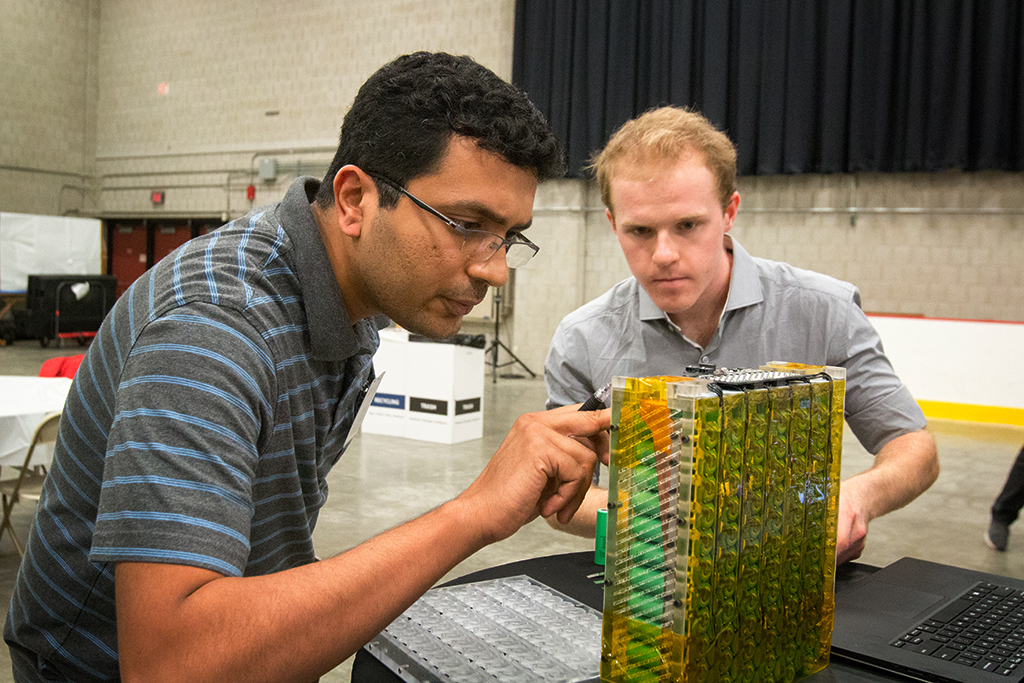From electric racecars to prosthetic feet – students present their research at annual exhibition
At the 4th Annual Mechanical Engineering Research Exhibition, students hone their communication skills by presenting their research projects.
The wind whipped down Mass Ave. Torrents of rain pelleted the roof of the Zesiger Sports and Fitness Center. The remnants of Hurricane Jose circled above.
Dry inside the Johnson Ice Rink, mechanical engineering graduate student Sydney Sroka had a different hurricane on her mind – Hurricane Guillermo. Data from 1997’s Hurricane Guillermo informed her research on improving hurricane intensity forecasts.
“The overwhelming majority of energy in a hurricane comes from warm seawater, which bubbles into sea spray because the wind is so fast,” Sroka explains, pointing to a figure of small water droplets. “The air temperature is mediated by these tiny drops of seaspray, that are affected by microphysics,” Sroka adds. By analyzing and modeling the heat of these drops of water, she hopes that forecasters can make more accurate predictions about a hurricane’s strength.
Sroka is one of the over 70 graduate students participating in the annual Mechanical Engineering Research Exhibition (MERE). In its fourth year, MERE, which is hosted by the Department of Mechanical Engineering and the Graduate Association of Mechanical Engineers, gives mechanical engineering graduate students, UROP participants, and postdocs a chance to present their work to alumni, faculty, and fellow students. Projects range from low-cost braille label makers to solar thermophotovoltaic systems and an in vitro intestinal organ model.
“I think it is very important community building event,” says Professor Nicholas Fang, MERE’s faculty advisor. “For our graduate students, this is a great opportunity to get to know each other. MERE is often their first exposure to other research activities in the department.”
MERE is more than just an opportunity for students to showcase the research they’re working on – one of its primary goals is to emphasize the importance of effective communication to a diverse audience.
The set-up is similar to a poster session at a scientific conference. Students stand in front of their posters and answer questions from attendees. At MERE, these attendees are mostly comprised of alumni and faculty who serve as judges. These judges aren’t just interested in what kind of research these students are presenting, but how the students are presenting the research. This setup enables students the ability to practice and hone their presentation skills and prepare for upcoming conferences or qualifying exams.
“I presented last year and it was a great experience and opportunity to get useful feedback on my work,” explains PhD candidate Arny Leroy, who presented this year on high performance incandescent lighting. “It’s helpful to practice presenting.”
Some students were able to exhibit live demos as a part of their presentation. During the first poster session, a robot designed to adhere to pedestrian rules whizzed around attendees. The robot was part of Michael Everett’s research project. Meanwhile Rachel Hoffman was able to show attendees a scale model of the multi-track elevator system she is working on for e-commerce fulfillment centers.
After the judges’ marks were tallied this year’s winners were announced. Here are a list of winners:
Best Overall/Understanding
Sebastian Pattinson – “Printed mesh materials with locally tailored elasticity for compliant wearable and implantable devices.”
Highest Impact
Arny Leroy – “High performance incandescent lighting”
Most Excitement
Elise Strobach – “Optically Transparent, Thermally Insulating and Soundproofing (OTTIS) Aerogel for High-Efficiency Window Applications
Best UROP
Ryan Koeppen – “Controlling Physical Interaction: Humans Do Not Minimize Energy”
Runner- Ups: Victor Prost, Vrushank Phadnis, Jerry Wang, Mohammad Farazmand, Sydney Sroka, Hyeon Yu Kim, Anoop Rajappan, Edward Burnell, Kevin Kung, and Cecile Chazot
Honorable Mention: Bethany Lettiere, Yi Huang, Abiodun Olaoye, Michael Everett, Bikram Bhatia, Xiaoyu Wu, Zheng Jie Tan, Andrew Bouma, Qifang Bao, Quantum Wei, Sahil Shah, and Yi Xue
The day was capped off with a keynote speech by former NASA astronaut Mike Massimino SM '88, PhD '92. Massimino chronicled his journey from his childhood on Long Island playing with an astronaut Snoopy toy to his time as an MIT graduate student living in a small apartment in Central Square and then finally his experience working on the Hubble Space Telescope as an astronaut.
Visit Our Photo Gallery of MERE '17



